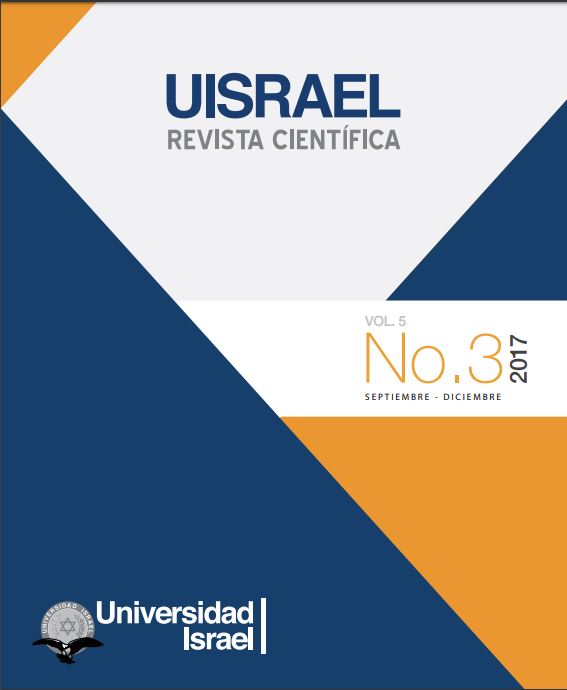Analysis of an exelearning guide in the teaching-learning process of students of the Instituto Tecnológico Superior Tecnoecuatoriano
DOI:
https://doi.org/10.35290/rcui.v4n3.2017.84Keywords:
Information and Communications Technology, eXeLearning, teaching- learning, teaching methodology, meaningful learningAbstract
Taking into account that technology and information is innovation in education, a study was made in order to analyze the eXeLearning author tool as a guide for students, the Instituto Tecnológico Supe-rior Tecnoecuatoriano, the use of this tool, was used as theoretical reference the relationship between teaching and learning as a meaningful learning process, where Vygotsky’s theory was taken as a basis, emphasizing how the student can integrate the new learning with the already existing and de-velop a new knowledge, this mediated by the teacher as a facilitator of the construct, for autonomous learning. The eXeLearning software was used as a guide in the subject of the Environment, since it serves as a tool and methodological strategy to be used in data collection both in the classroom and outside it. A structured survey was applied to a sample of teachers and students of the third semes-ter of the career of Automotive Mechanics of the Instituto Tecnológico Superior Tecnoecuatoriano , with which it was determined that the use of the eXeLearning tool produces a change in the practice of teaching by the teachers as it breaks structures and leads to teaching the use of innovation in the teaching process. On the other hand, students know the technology and value the use of this tool in the classroom, as this led to an extra motivation when learning and forming knowledge.
Downloads
References
Alarcón, P., Álvarez, X., Hernández, D. y Maldonado, D. (2013). Matriz de habilidades TIC para el aprendizaje. Santiago de Chile: Ministerio de educación. Recuperado de https://s3.amazonaws.com/academia.edu.
documents/31723603/LibroSIMCETICbaj a.pdf?WSAccessKeyId=AKIAIWOWYYGZ2Y53UL3A&Expires=1535822016& Signature=FBl9opuI%2BkDSZoOAFAAApgEvfJY%3D&response-content- disposition=inline%3B%20filename%3DHabilidades_TICs_para_el_aprendizaje_y_s.pdf#page=16
Allueva, A. I. (coordinador) & Alejandre, J. L. (2017). Aportaciones de las tecnologías como eje en el nuevo paradigma educativo. Zaragoza, España: Prensas de la Universidad de Zaragoza.
Área, M., San Nicolás, M. B. y Fariña, E. (2010). Buenas prácticas de aulas virtuales en la docencia universitaria presencial. En De Pablos trabajo/index.php/revistatesi/article/view/5787/5817 ISSN: 1138-9737.
Dimensiones
Ausubel, D. Novak, J. & Hanesian, H. (2009). Psicología Educativa: Un punto de vista cognoscitivo. 2 ed. México, México: Trillas.
Barreto, C. R. y Iriarte, F. (2017). Las TIC en educación superior: Experiencias de innovación. Barranquilla, Colombia: Universidad del Norte.
Bustos, A., y Román, M. (2016). La importancia de evaluar la incorporación y el uso de las TIC en educación. Revista Iberoamericana de Evaluación Educativa 2011, 4 (2).
Cabrera, J., Barroso, J. (2014). Nuevos escenarios digitales. España: Ediciones Pirámide.
Díaz, F. & Hernández. (2002). Estrategias docentes para un aprendizaje significativo. Una interpretación constructivista. 2da edición México (México): McGraw-Hill Interamericana. ISBN 970-10-3526-7
Gavilanes, N.V. (2015). Manual interactivo en formato de página web para la Enseñanza-aprendizaje de la asignatura aplicaciones de computación utilizando herramientas de autor para el i.t.s. “consejo provincial de pichincha”. (Tesis de Maestría). Quito, Ecuador: Universidad Tecnológica Israel. Recuperado de Hermann, A. (2015). Narrativas digitales como didácticas y estrategias de aprendizaje en los procesos de asimilación y retención del conocimiento. Sophia, Colección de la filosofía de la educación, 19(2), 253-270.
Olmedo, N. y Farrerons, O. (2017). Modelos constructivistas de aprendizaje en programas de formación. Cataluña, España: Omnia. Universidad Politécnica Catalunya.
Orozco, C. M. (2017). Objetos de Aprendizaje con exe-learning y GeoGebra para la definición y representación geométrica de operaciones con vectores y sus aplicaciones. (Tesis Doctoral). Universidad de Salamanca,España. Recuperado de https://repositorio.grial.eu/handle/grial/772
PIED (2012). Tutorial integración de eXeLearning con Edmodo. Preparar actividades y compartirlas en redes sociales [en línea]. Buenos Aires, Argentina: Plan Integral de Educación Digital – Ministerio de Educación.
Colección de aplicaciones gratuitas para contextos educativos. 12.
Ruiz, F.J. (2007). Modelos didácticos para la enseñanza de las ciencias naturales. Revista Latinoamericana de Estudios Educativos, 3(2) (Jul/Dic), 41-60. Manizales, Colombia: Universidad de Caldas, ISSN: 1900-9895.
Sáez, J. M. y Ruiz, J. R. (2013). Enseñanza de la ciencia, tecnología educativa y escuela rural: un estudio de caso. Revista Electrónica de Enseñanza de las Ciencias, 12(1), 45-61. Recuperado de http://repositorio.minedu.gob.pe/handle/123456789/1387
Vygotsky, L. (1978), Pensamiento y lenguaje. Madrid, España: Paidós.
Vygotsky, L. (2013). Pensamiento y lenguaje. Madrid, España: Grupo planeta, Editorial Paidós.
Downloads
Published
Issue
Section
License
Copyright (c) 2017 Revista Científica UISRAEL

This work is licensed under a Creative Commons Attribution 4.0 International License.
Los autores que participen de los procesos de evaluación y publicación de sus ediciones conservan los derechos de autor y ceden a la revista el derecho a la primera publicación, tal como establecen las condiciones de reconocimiento en la licencia Creative Commons Reconocimiento 4.0 Internacional (CC BY), donde los autores autorizan el libre acceso a sus obras, permitiendo que los lectores copien, distribuyan y transmitan por diversos medios, garantizando una amplia difusión del conocimiento científico publicado.
- Toda derivación, a partir de esta obra, deberá citar la fuente y a la primera publicación en esta revista. Se permiten derechos comerciales no lucrativos sobre sus contenidos.
- Los autores pueden realizar otros acuerdos contractuales independientes y adicionales para la distribución no exclusiva de la versión del artículo publicado en esta revista, es decir, podrán incluirlo en un repositorio institucional o publicarlo en un libro, siempre que indiquen claramente que el trabajo se publicó por primera vez en esta revista.
- Se permite y recomienda a los autores compartir su trabajo en línea, con la finalidad de intercambios productivos para una mayor y más rápida citación del trabajo como lo establece los efectos del movimiento ‘Acceso Abierto’.
- No puede aplicar términos legales o medidas tecnológicas que restrinjan legalmente a otros de hacer cualquier cosa que permita la licencia: https://creativecommons.org/licenses/by/4.0/deed.es
- La Revista Científica es financiada completamente de los aportes realizados por nuestra entidad editora: Universidad Tecnológica Israel; por tal motivo, no establece cargos o cobros de ninguna índole a sus autores y colaboradores, así como tampoco genera pagos o remuneraciones de ningún tipo a ellos.
- Se asignará un Digital Object Identifier (DOI) a cada publicación.







